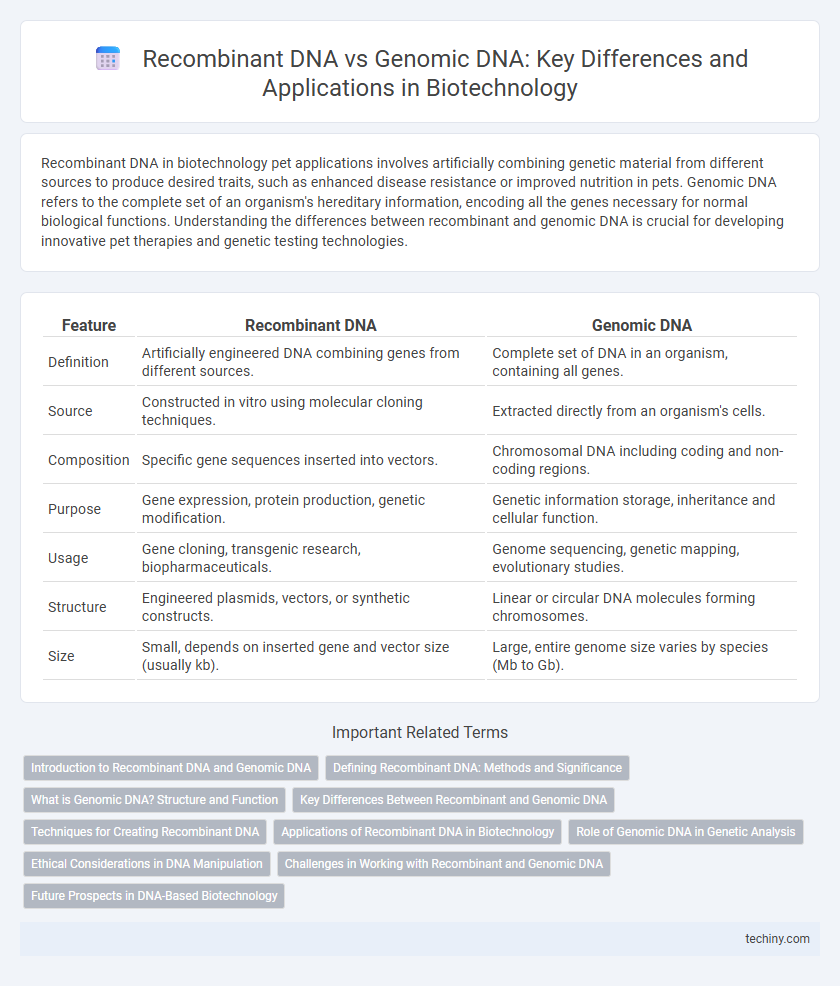Recombinant DNA in biotechnology pet applications involves artificially combining genetic material from different sources to produce desired traits, such as enhanced disease resistance or improved nutrition in pets. Genomic DNA refers to the complete set of an organism's hereditary information, encoding all the genes necessary for normal biological functions. Understanding the differences between recombinant and genomic DNA is crucial for developing innovative pet therapies and genetic testing technologies.
Table of Comparison
| Feature | Recombinant DNA | Genomic DNA |
|---|---|---|
| Definition | Artificially engineered DNA combining genes from different sources. | Complete set of DNA in an organism, containing all genes. |
| Source | Constructed in vitro using molecular cloning techniques. | Extracted directly from an organism's cells. |
| Composition | Specific gene sequences inserted into vectors. | Chromosomal DNA including coding and non-coding regions. |
| Purpose | Gene expression, protein production, genetic modification. | Genetic information storage, inheritance and cellular function. |
| Usage | Gene cloning, transgenic research, biopharmaceuticals. | Genome sequencing, genetic mapping, evolutionary studies. |
| Structure | Engineered plasmids, vectors, or synthetic constructs. | Linear or circular DNA molecules forming chromosomes. |
| Size | Small, depends on inserted gene and vector size (usually kb). | Large, entire genome size varies by species (Mb to Gb). |
Introduction to Recombinant DNA and Genomic DNA
Recombinant DNA technology involves combining DNA molecules from different sources to create novel genetic sequences, enabling targeted gene manipulation and the production of genetically modified organisms. Genomic DNA refers to the complete set of an organism's hereditary material, encompassing all genes and non-coding sequences present in the nucleus or mitochondria. Understanding the distinctions between recombinant DNA and genomic DNA is fundamental for applications in genetic engineering, molecular cloning, and gene therapy.
Defining Recombinant DNA: Methods and Significance
Recombinant DNA involves the artificial combination of DNA sequences from different sources using techniques such as restriction enzyme digestion and ligation to create novel genetic constructs. This technology enables precise manipulation of genetic material for applications including gene cloning, protein production, and gene therapy. Its significance lies in advancing biotechnology by allowing targeted modification and expression of specific genes beyond the natural configuration found in genomic DNA.
What is Genomic DNA? Structure and Function
Genomic DNA encompasses the complete set of genetic material within an organism's chromosomes, containing both coding sequences (genes) and non-coding regions essential for regulation and genome stability. Its double-helix structure, composed of nucleotides adenine, thymine, cytosine, and guanine, stores hereditary information used for protein synthesis and cellular function. Genomic DNA enables replication and transcription processes critical for growth, development, and inheriting traits in all living organisms.
Key Differences Between Recombinant and Genomic DNA
Recombinant DNA is artificially engineered by combining DNA sequences from different sources, enabling specific gene manipulation, while genomic DNA represents the complete set of an organism's natural hereditary information. Recombinant DNA is commonly used in genetic engineering and synthetic biology to express desired proteins or modify genetic traits, whereas genomic DNA serves as the blueprint for all biological functions and inheritance. The primary difference lies in recombination and application: recombinant DNA is a targeted, constructed molecule, whereas genomic DNA encompasses the entire genetic material within an organism's nucleus.
Techniques for Creating Recombinant DNA
Techniques for creating recombinant DNA primarily involve the use of restriction enzymes to cut DNA at specific sequences, allowing fragments from different sources to be joined together using DNA ligase. Polymerase chain reaction (PCR) amplifies target DNA sequences before insertion into vectors such as plasmids, facilitating gene cloning or expression. Electroporation and heat shock are common methods for introducing recombinant DNA into host cells, enabling the study and production of genetically modified proteins.
Applications of Recombinant DNA in Biotechnology
Recombinant DNA technology enables the insertion of specific genes into host organisms, facilitating the production of insulin, growth hormones, and vaccines at a commercial scale. This precise gene manipulation allows for the development of genetically modified crops with enhanced resistance to pests and environmental stress. Compared to genomic DNA, recombinant DNA provides targeted genetic modifications, accelerating advancements in gene therapy and pharmaceutical biotechnology.
Role of Genomic DNA in Genetic Analysis
Genomic DNA serves as the complete set of genetic information within an organism, enabling comprehensive genetic analysis and identification of inherited traits, mutations, and genetic disorders. Unlike recombinant DNA, which is engineered by combining DNA fragments from different sources, genomic DNA provides the native sequence context essential for studying gene function, regulation, and chromosomal organization. Advances in genomic DNA sequencing technologies have revolutionized personalized medicine, population genetics, and comparative genomics by offering precise insights into genetic variations.
Ethical Considerations in DNA Manipulation
Recombinant DNA manipulation raises ethical concerns regarding gene editing's impact on biodiversity and potential unintended consequences in ecosystems, while genomic DNA research involves privacy issues surrounding genetic information and consent. Ethical frameworks stress the importance of transparency, informed consent, and rigorous risk assessments in both methodologies to prevent misuse and ensure responsible scientific advancements. Regulatory bodies like the NIH and UNESCO provide guidelines to balance innovation with ethical responsibility in DNA manipulation practices.
Challenges in Working with Recombinant and Genomic DNA
Challenges in working with recombinant DNA include ensuring precise insertion of target genes without disrupting host genome integrity and overcoming limitations in vector capacity for large DNA fragments. Genomic DNA poses difficulties due to its complex structure, high molecular weight, and the presence of repetitive sequences that complicate accurate sequencing and manipulation. Both require advanced techniques for purification, amplification, and integration to achieve reliable experimental outcomes in biotechnology applications.
Future Prospects in DNA-Based Biotechnology
Recombinant DNA technology offers precise gene editing and protein production capabilities that drive innovations in gene therapy and synthetic biology. Future prospects include the development of personalized medicine and bioengineered organisms tailored for environmental sustainability. Genomic DNA analysis continues to enhance understanding of complex traits and disease mechanisms, enabling advances in precision diagnostics and genome-wide association studies.
recombinant DNA vs genomic DNA Infographic

 techiny.com
techiny.com